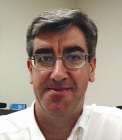Awardee Interviews | Biography: Stephen J. Pearton
Stephen J. Pearton

"For pioneering the science and application of advanced device fabrication techniques, including plasma etching, ion implantation for doping and electrical isolation, and formation of Ohmic and Schottky contacts for compound semiconductors."
Stephen J. Pearton is Distinguished Professor and Alumni Chair in the Department of Materials Science and Engineering at the University of Florida. Prior to joining UF in 1994 he was a Member of Technical Staff at AT&T Bell Laboratories in Murray Hill, NJ for 10 years where he was responsible for developing new process and fabrication methods for compound semiconductor devices used on data transmission systems.
He completed his B.S. in Physics at the University of Tasmania in Australia in 1978 and carried out his Ph.D research at the Australian Atomic Energy Commission under a scholarship from the Australian Institute of Nuclear Science and Engineering. He was a postdoctoral researcher at the University of California, Berkeley and Lawrence Berkeley Lab from 1982-1983. He is a Fellow of AVS, the American Physical Society(APS), The Electrochemical Society (ECS), the Institute of Electrical and Electronics Engineers (IEEE) and The Minerals, Metals and Materials Society(TMS). He is author of 1300 journal articles on electronic materials, physics of semiconductors, hydrogen in solids and device processing, 34 book chapters, 12 books, 12 patents and has received over 23,000 citations in professional journals. He has served as editor of Solid State Electronics, associate editor of both JVST Aand B and is on the editorial board of Applied Physics Letters, Journal of Applied Physics, Applied Physics Reviews, Materials Today, Materials Science and Engineering Reports.
His work encompasses a broad, multi-disciplinary approach, borrowing from physics, chemistry, electrical, chemical and materials science and engineering to understand the effects of processing techniques on the performance of advanced compound semiconductor devices. These contributions have been critical to the commercialization of these devices in cell phones, wireless communication systems, collision-avoidance radar, high density DVDs and traffic lights and other displays. Many of the companies manufacturing these products use fabrication processes that are based on results initially developed by Pearton. His current work focuses on development of novel sensors, transparent thin film electronics and visible and UV laser and light-emitting diodes.
He has presented more then 250 invited talks at national or international scientific conferences and won the ECS Electronics Division Award in 2005. He is married to Cammy Abernathy (also an AVS Fellow) and has an 8 year old son, Max, who is a great fan of the Florida Gators in all sports.